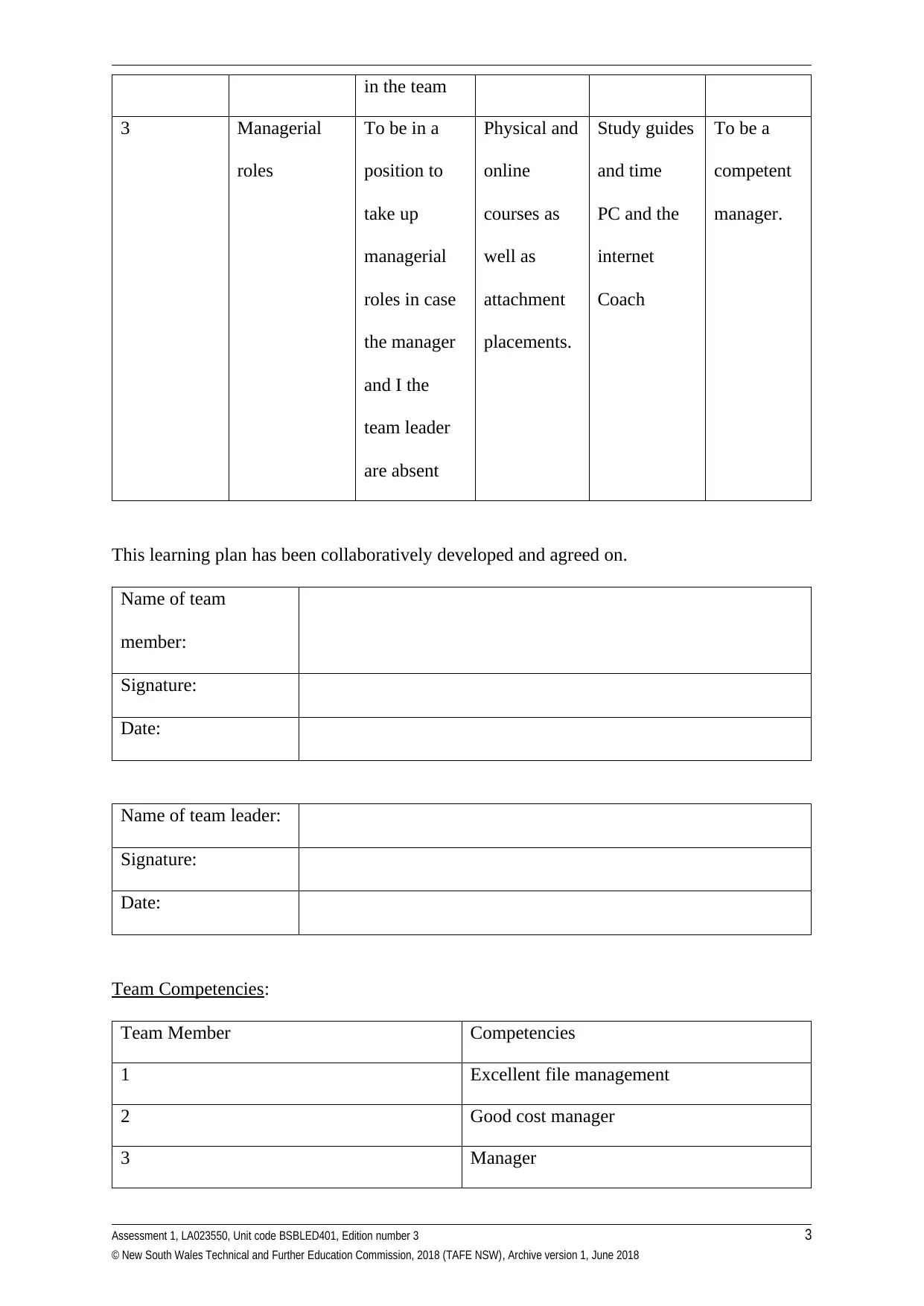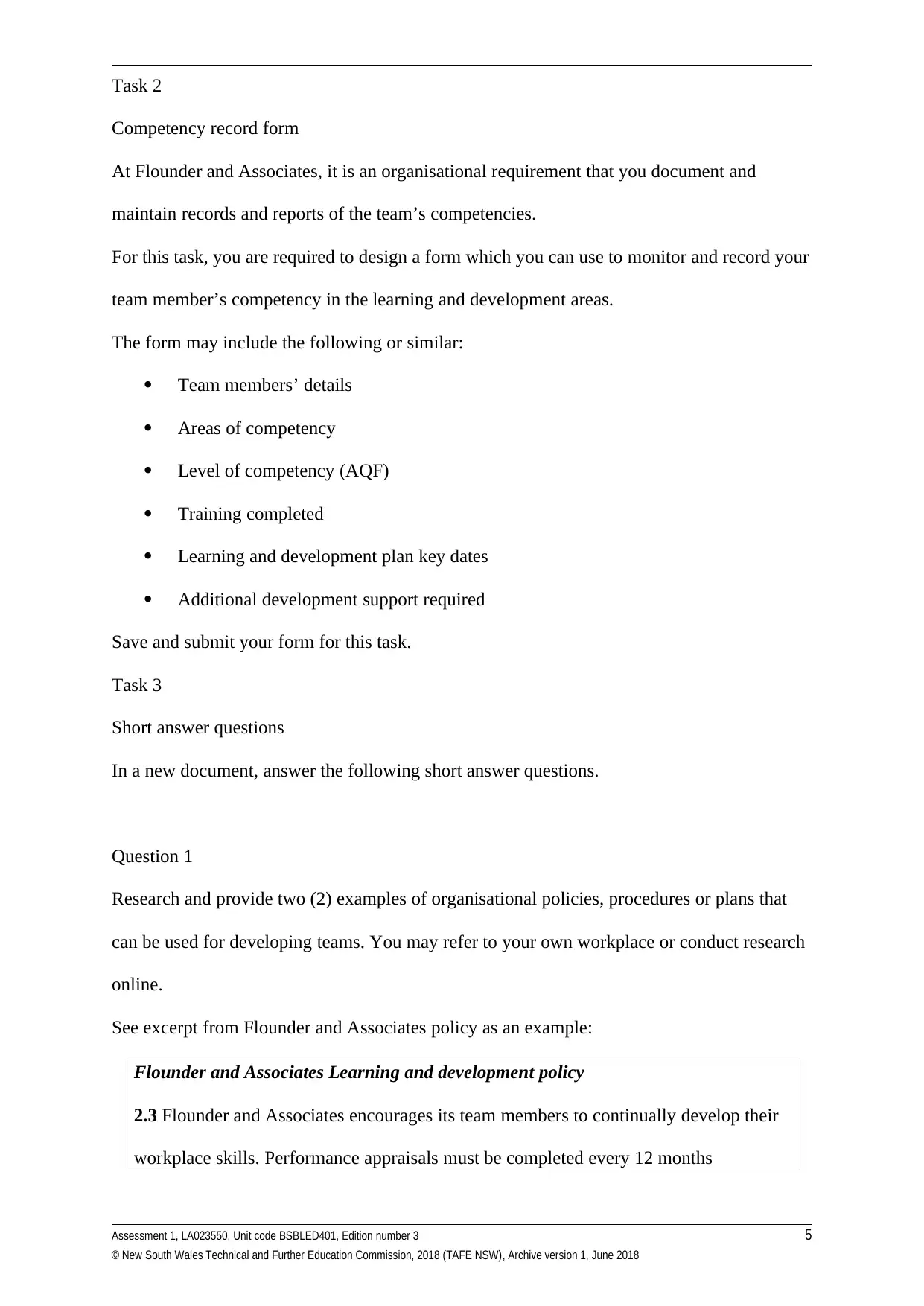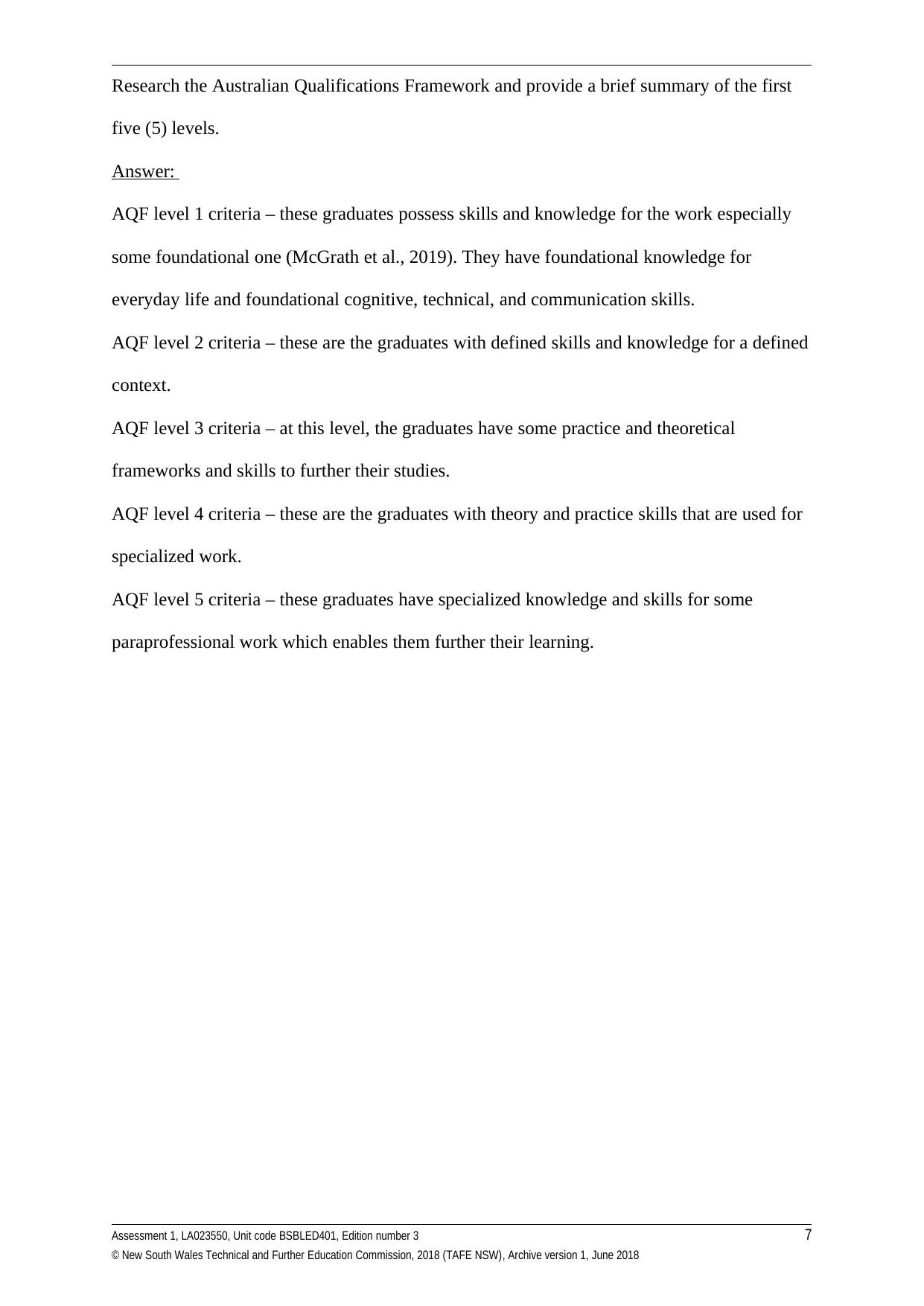BSBLED401 Assessment 1: Developing Learning Plans for Admin Team
VerifiedAdded on 2022/08/24
|8
|1875
|23
Homework Assignment
AI Summary
This document provides a comprehensive solution for BSBLED401 Assessment 1, focusing on the development of a team within the context of a legal firm, Flounder and Associates. The assignment requires the team leader to determine the learning and development needs of administrative staff, create individual learning plans, and design a form to record team competencies. It also includes short answer questions exploring organizational policies, facilitation techniques, the Australian Qualifications Framework (AQF), and suitable training for a team member aspiring to a management role. The solution covers skills audits, performance assessment, and the creation of competency records, providing a detailed overview of the team development process. The assignment highlights the importance of effective training and development in a workplace setting, including the exploration of AQF levels and relevant business management courses. It emphasizes practical application of skills and knowledge in identifying and implementing learning opportunities for others.

BSBLED401: Assessment 1
What you need to do
For this assessment, you will determine the development needs of your team, assess
performance and prepare to record competency in learning and development areas.
This assessment allows you to demonstrate your skills and knowledge identifying and
implementing learning opportunities for others.
Scenario
You are the team leader at the busy legal firm, Flounder and Associates. You are responsible
for the learning and development of the small administrative team you lead.
In your role, you are required to systematically identify and implement the training and
development needs of your workplace team. To do this you need to determine the learning
requirements for your team members and collaboratively develop learning plans.
Your team members are Stephanie Carp, Antonio Conti and Jonathan Ku. These team
members are employed as administrative assistants.
Task 1
Learning and development plans
Currently, there is an opportunity to provide the team with further training. Before this
training can be conducted, you will need to determine the learning and development needs of
your team.
To begin, download the skills audits from the OLS.
Using the skills audits, assess each team member’s performance to determine:
The effectiveness of previous development programs
Each team member’s learning and development needs
In consideration of the above:
Develop a draft learning and development plan for each team member
Assessment 1, LA023550, Unit code BSBLED401, Edition number 3 1
© New South Wales Technical and Further Education Commission, 2018 (TAFE NSW), Archive version 1, June 2018
What you need to do
For this assessment, you will determine the development needs of your team, assess
performance and prepare to record competency in learning and development areas.
This assessment allows you to demonstrate your skills and knowledge identifying and
implementing learning opportunities for others.
Scenario
You are the team leader at the busy legal firm, Flounder and Associates. You are responsible
for the learning and development of the small administrative team you lead.
In your role, you are required to systematically identify and implement the training and
development needs of your workplace team. To do this you need to determine the learning
requirements for your team members and collaboratively develop learning plans.
Your team members are Stephanie Carp, Antonio Conti and Jonathan Ku. These team
members are employed as administrative assistants.
Task 1
Learning and development plans
Currently, there is an opportunity to provide the team with further training. Before this
training can be conducted, you will need to determine the learning and development needs of
your team.
To begin, download the skills audits from the OLS.
Using the skills audits, assess each team member’s performance to determine:
The effectiveness of previous development programs
Each team member’s learning and development needs
In consideration of the above:
Develop a draft learning and development plan for each team member
Assessment 1, LA023550, Unit code BSBLED401, Edition number 3 1
© New South Wales Technical and Further Education Commission, 2018 (TAFE NSW), Archive version 1, June 2018
Paraphrase This Document
Need a fresh take? Get an instant paraphrase of this document with our AI Paraphraser

Ensure that the goals and objectives match the knowledge and skills requirements of
competency standards relevant to the industry
Save each plan separately to enable it to be stored in the team member’s
employment file.
Answer:
Learning and Development Plan
Plan start date:
Plan end date:
Team
Member
Name and
Role
Learning and
Development
Area
Learning
Goals and
Objectives
Training
Method/
Activity
Support
Materials
Length &
Timeframe
1
File
Management
To develop
electronic file
management
skills to
enable
creation of
store filing
system
Online
course
Computer
and internet
access
Allocated
study times
To be
completed
before end
of financial
year
2 Cost
management
To be in a
position to
manage
finances used
for expenses
Physical
course
Internet and
a PC
Coach
To be a
competent
cost
manager.
2 Assessment 1, LA023550, Unit code BSBLED401, Edition number 3
© New South Wales Technical and Further Education Commission, 2018 (TAFE NSW), Archive version 1, June 2018
competency standards relevant to the industry
Save each plan separately to enable it to be stored in the team member’s
employment file.
Answer:
Learning and Development Plan
Plan start date:
Plan end date:
Team
Member
Name and
Role
Learning and
Development
Area
Learning
Goals and
Objectives
Training
Method/
Activity
Support
Materials
Length &
Timeframe
1
File
Management
To develop
electronic file
management
skills to
enable
creation of
store filing
system
Online
course
Computer
and internet
access
Allocated
study times
To be
completed
before end
of financial
year
2 Cost
management
To be in a
position to
manage
finances used
for expenses
Physical
course
Internet and
a PC
Coach
To be a
competent
cost
manager.
2 Assessment 1, LA023550, Unit code BSBLED401, Edition number 3
© New South Wales Technical and Further Education Commission, 2018 (TAFE NSW), Archive version 1, June 2018

in the team
3 Managerial
roles
To be in a
position to
take up
managerial
roles in case
the manager
and I the
team leader
are absent
Physical and
online
courses as
well as
attachment
placements.
Study guides
and time
PC and the
internet
Coach
To be a
competent
manager.
This learning plan has been collaboratively developed and agreed on.
Name of team
member:
Signature:
Date:
Name of team leader:
Signature:
Date:
Team Competencies:
Team Member Competencies
1 Excellent file management
2 Good cost manager
3 Manager
Assessment 1, LA023550, Unit code BSBLED401, Edition number 3 3
© New South Wales Technical and Further Education Commission, 2018 (TAFE NSW), Archive version 1, June 2018
3 Managerial
roles
To be in a
position to
take up
managerial
roles in case
the manager
and I the
team leader
are absent
Physical and
online
courses as
well as
attachment
placements.
Study guides
and time
PC and the
internet
Coach
To be a
competent
manager.
This learning plan has been collaboratively developed and agreed on.
Name of team
member:
Signature:
Date:
Name of team leader:
Signature:
Date:
Team Competencies:
Team Member Competencies
1 Excellent file management
2 Good cost manager
3 Manager
Assessment 1, LA023550, Unit code BSBLED401, Edition number 3 3
© New South Wales Technical and Further Education Commission, 2018 (TAFE NSW), Archive version 1, June 2018
⊘ This is a preview!⊘
Do you want full access?
Subscribe today to unlock all pages.

Trusted by 1+ million students worldwide

4 Assessment 1, LA023550, Unit code BSBLED401, Edition number 3
© New South Wales Technical and Further Education Commission, 2018 (TAFE NSW), Archive version 1, June 2018
© New South Wales Technical and Further Education Commission, 2018 (TAFE NSW), Archive version 1, June 2018
Paraphrase This Document
Need a fresh take? Get an instant paraphrase of this document with our AI Paraphraser

Task 2
Competency record form
At Flounder and Associates, it is an organisational requirement that you document and
maintain records and reports of the team’s competencies.
For this task, you are required to design a form which you can use to monitor and record your
team member’s competency in the learning and development areas.
The form may include the following or similar:
Team members’ details
Areas of competency
Level of competency (AQF)
Training completed
Learning and development plan key dates
Additional development support required
Save and submit your form for this task.
Task 3
Short answer questions
In a new document, answer the following short answer questions.
Question 1
Research and provide two (2) examples of organisational policies, procedures or plans that
can be used for developing teams. You may refer to your own workplace or conduct research
online.
See excerpt from Flounder and Associates policy as an example:
Flounder and Associates Learning and development policy
2.3 Flounder and Associates encourages its team members to continually develop their
workplace skills. Performance appraisals must be completed every 12 months
Assessment 1, LA023550, Unit code BSBLED401, Edition number 3 5
© New South Wales Technical and Further Education Commission, 2018 (TAFE NSW), Archive version 1, June 2018
Competency record form
At Flounder and Associates, it is an organisational requirement that you document and
maintain records and reports of the team’s competencies.
For this task, you are required to design a form which you can use to monitor and record your
team member’s competency in the learning and development areas.
The form may include the following or similar:
Team members’ details
Areas of competency
Level of competency (AQF)
Training completed
Learning and development plan key dates
Additional development support required
Save and submit your form for this task.
Task 3
Short answer questions
In a new document, answer the following short answer questions.
Question 1
Research and provide two (2) examples of organisational policies, procedures or plans that
can be used for developing teams. You may refer to your own workplace or conduct research
online.
See excerpt from Flounder and Associates policy as an example:
Flounder and Associates Learning and development policy
2.3 Flounder and Associates encourages its team members to continually develop their
workplace skills. Performance appraisals must be completed every 12 months
Assessment 1, LA023550, Unit code BSBLED401, Edition number 3 5
© New South Wales Technical and Further Education Commission, 2018 (TAFE NSW), Archive version 1, June 2018

Answer:
There are various examples of organizational policies, procedures, or plans that can be
used for developing teams (Aghina et al., 2019). In organizations, one of the key policy is
managing and encouraging diversity. Diversification is one of the major policies that many
organizations employ. Organizations manage diversity as a way to develop teams since when
the teams are diverse, problems are solved easily, clinical care of the decisions are done, and
creativity is improved. This aspect involves expertise diversity and leadership roles (Shea et
al., 2018). The other policy is providing performance feedback and team rewards. Through
this, the teams are developed together with great appreciation to the input made. The
development under this policy is bound on the recognition and quality performances.
Question 2
Describe three (3) facilitation techniques which can help encourage team development and
improvement.
Answer:
When it comes to the facilitation techniques, there are a lot of them that can be
employed to a team in which they can help encourage team development and improvement.
One of these techniques is action planning (Aubé et al., 2018). This is a process that helps
achieve team success. This technique helps in commitment. When actions are planned,
progress is usually tracked and easily reported at each level. Brainstorming is another
technique that helps in developing teams. Through brainstorming, many ideas are set which
helps in effective management and evaluation (Jenkins, 2017). Meta-planning is another
technique. Through this, the team is able to express decisions and thoughts of the issues in
discussions.
Question 3
6 Assessment 1, LA023550, Unit code BSBLED401, Edition number 3
© New South Wales Technical and Further Education Commission, 2018 (TAFE NSW), Archive version 1, June 2018
There are various examples of organizational policies, procedures, or plans that can be
used for developing teams (Aghina et al., 2019). In organizations, one of the key policy is
managing and encouraging diversity. Diversification is one of the major policies that many
organizations employ. Organizations manage diversity as a way to develop teams since when
the teams are diverse, problems are solved easily, clinical care of the decisions are done, and
creativity is improved. This aspect involves expertise diversity and leadership roles (Shea et
al., 2018). The other policy is providing performance feedback and team rewards. Through
this, the teams are developed together with great appreciation to the input made. The
development under this policy is bound on the recognition and quality performances.
Question 2
Describe three (3) facilitation techniques which can help encourage team development and
improvement.
Answer:
When it comes to the facilitation techniques, there are a lot of them that can be
employed to a team in which they can help encourage team development and improvement.
One of these techniques is action planning (Aubé et al., 2018). This is a process that helps
achieve team success. This technique helps in commitment. When actions are planned,
progress is usually tracked and easily reported at each level. Brainstorming is another
technique that helps in developing teams. Through brainstorming, many ideas are set which
helps in effective management and evaluation (Jenkins, 2017). Meta-planning is another
technique. Through this, the team is able to express decisions and thoughts of the issues in
discussions.
Question 3
6 Assessment 1, LA023550, Unit code BSBLED401, Edition number 3
© New South Wales Technical and Further Education Commission, 2018 (TAFE NSW), Archive version 1, June 2018
⊘ This is a preview!⊘
Do you want full access?
Subscribe today to unlock all pages.

Trusted by 1+ million students worldwide

Research the Australian Qualifications Framework and provide a brief summary of the first
five (5) levels.
Answer:
AQF level 1 criteria – these graduates possess skills and knowledge for the work especially
some foundational one (McGrath et al., 2019). They have foundational knowledge for
everyday life and foundational cognitive, technical, and communication skills.
AQF level 2 criteria – these are the graduates with defined skills and knowledge for a defined
context.
AQF level 3 criteria – at this level, the graduates have some practice and theoretical
frameworks and skills to further their studies.
AQF level 4 criteria – these are the graduates with theory and practice skills that are used for
specialized work.
AQF level 5 criteria – these graduates have specialized knowledge and skills for some
paraprofessional work which enables them further their learning.
Assessment 1, LA023550, Unit code BSBLED401, Edition number 3 7
© New South Wales Technical and Further Education Commission, 2018 (TAFE NSW), Archive version 1, June 2018
five (5) levels.
Answer:
AQF level 1 criteria – these graduates possess skills and knowledge for the work especially
some foundational one (McGrath et al., 2019). They have foundational knowledge for
everyday life and foundational cognitive, technical, and communication skills.
AQF level 2 criteria – these are the graduates with defined skills and knowledge for a defined
context.
AQF level 3 criteria – at this level, the graduates have some practice and theoretical
frameworks and skills to further their studies.
AQF level 4 criteria – these are the graduates with theory and practice skills that are used for
specialized work.
AQF level 5 criteria – these graduates have specialized knowledge and skills for some
paraprofessional work which enables them further their learning.
Assessment 1, LA023550, Unit code BSBLED401, Edition number 3 7
© New South Wales Technical and Further Education Commission, 2018 (TAFE NSW), Archive version 1, June 2018
Paraphrase This Document
Need a fresh take? Get an instant paraphrase of this document with our AI Paraphraser

Question 4
As the company grows, there is potential for one of your team members to progress to a
management role. Research which AQF level training would be suitable and suggest a course
they could undertake.
Answer:
Based on the potential and the skills of my teammates, as well as the AQF levels of
training, choosing the suitable level and the right course is crucial to ensure that the team
member will be in a position to progress with their management role. The training level that I
would be suitable for the team member would be the bachelor’s degree. This is because at
that level, one is able to acquire coherent and a broad range of knowledge, values, and skills
for professional duties and work (McGrath et al., 2019). Since the team member aims at
expanding her knowledge in order to be able to progress to the management role, the
bachelor’s degree level of training is appropriate. Under this level, the course they could
undertake is business management. Having a bachelor’s degree in business management
equips one with the knowledge and appropriate skills of how to go about managing
businesses as well as different projects within an organization. These skills will be very
crucial to my team mate as well as to the entire team as well. Besides, with a bachelor’s
degree, it is possible for one to further their learning if need be.
Checklist
I have:
Created a draft learning plan for each team member
Created a form to record team competencies
Answered all the short answer questions
If you are unable to complete this task for a specific reason, please contact your teacher to
discuss alternative arrangements for demonstrating your skills and knowledge.
8 Assessment 1, LA023550, Unit code BSBLED401, Edition number 3
© New South Wales Technical and Further Education Commission, 2018 (TAFE NSW), Archive version 1, June 2018
As the company grows, there is potential for one of your team members to progress to a
management role. Research which AQF level training would be suitable and suggest a course
they could undertake.
Answer:
Based on the potential and the skills of my teammates, as well as the AQF levels of
training, choosing the suitable level and the right course is crucial to ensure that the team
member will be in a position to progress with their management role. The training level that I
would be suitable for the team member would be the bachelor’s degree. This is because at
that level, one is able to acquire coherent and a broad range of knowledge, values, and skills
for professional duties and work (McGrath et al., 2019). Since the team member aims at
expanding her knowledge in order to be able to progress to the management role, the
bachelor’s degree level of training is appropriate. Under this level, the course they could
undertake is business management. Having a bachelor’s degree in business management
equips one with the knowledge and appropriate skills of how to go about managing
businesses as well as different projects within an organization. These skills will be very
crucial to my team mate as well as to the entire team as well. Besides, with a bachelor’s
degree, it is possible for one to further their learning if need be.
Checklist
I have:
Created a draft learning plan for each team member
Created a form to record team competencies
Answered all the short answer questions
If you are unable to complete this task for a specific reason, please contact your teacher to
discuss alternative arrangements for demonstrating your skills and knowledge.
8 Assessment 1, LA023550, Unit code BSBLED401, Edition number 3
© New South Wales Technical and Further Education Commission, 2018 (TAFE NSW), Archive version 1, June 2018
1 out of 8
Related Documents
Your All-in-One AI-Powered Toolkit for Academic Success.
+13062052269
info@desklib.com
Available 24*7 on WhatsApp / Email
![[object Object]](/_next/static/media/star-bottom.7253800d.svg)
Unlock your academic potential
Copyright © 2020–2025 A2Z Services. All Rights Reserved. Developed and managed by ZUCOL.





